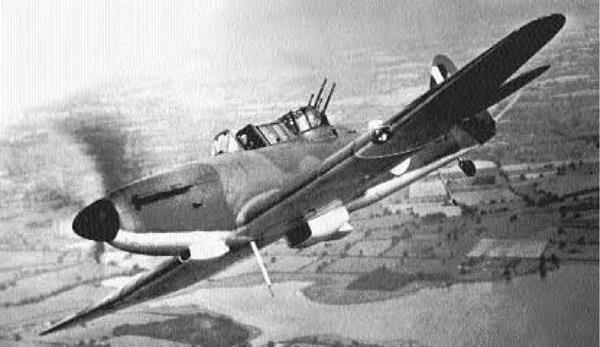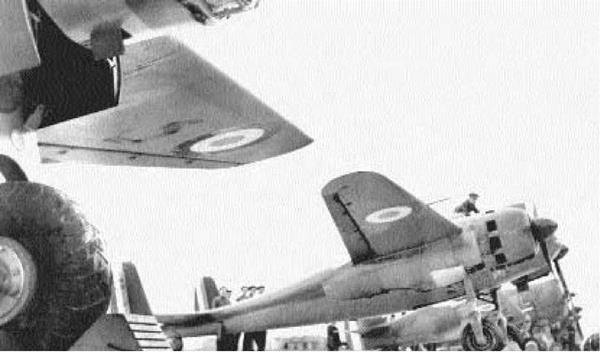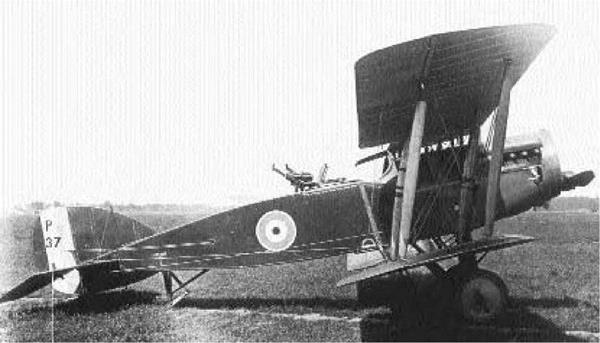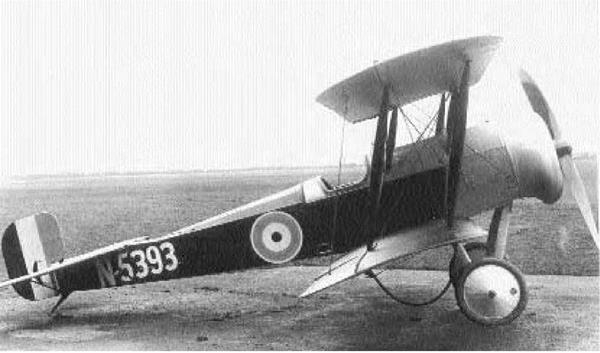. Blohm und Voss Bv 222 Wiking
Type: Transport; Reconnaissance
Dimensions: wingspan, 150 feet, 11 inches; length, 121 feet, 4 inches; height, 35 feet, 9 inches
Weights: empty, 67,572 pounds; gross, 108,030 pounds
Power plant: 6 x 1,000-horsepower BMW Fafnir 323R radial engines
Performance: maximum speed, 242 miles per hour; ceiling, 23,950 feet; range, 3,787 miles
Armament: 3 x 20mm cannons; 5 x 13mm machine guns
Service dates: 1940-1945
|
T |
he mighty Wiking was the largest flying boat to achieve operational status during World War II. It served extensively from Norway to the Mediterranean before heavy losses restricted its deployment.
In 1937 the airline Deutsche Lufthansa requested development of a new flying boat capable of nonstop service between Germany and New York. Such a craft would have to carry up to 24 passengers and remain airborne for 20 hours. A Blohm und Voss design team under Dr. Richard Vogt conceived such a craft in September 1940. It was a large, all-metal, high-wing monoplane with six engines. In typical Vogt fashion, the enormous wing mainspar functioned as both engine mount and fuel tank. The craft also possessed retractable stabilizing floats near the wingtips that drew up into recesses. The Bv 222 prototype originally flew in civilian markings, but by this time Germany was at war. Thereafter, it was pressed into service as an unarmed transport and flew on many occasions between Norway and the Mediterranean. As flying boats, Bv 222s were mar
ginally larger than the Kawanishi H8K and Short
Sunderland.
Continuous development of the Bv 222, called Wiking by its crews, resulted in an additional nine prototypes and four production models. These differed from the original version in being armed with an array of weapons. Several ended up in the hands of Lufttranportstaffel See (naval transport squadron) 222, which was organized to operate such large craft. Fully loaded, a Wiking could carry up to 92 fully equipped troops or 72 stretchers. Their tremendous range and endurance also made them ideal for maritime reconnaissance. One even managed to surprise and shoot down an Avro Lancaster at sea. However, the presence of British long-range fighters made unescorted Wiking missions hazardous, and several were lost in action. By 1944 the surviving six machines were restricted to medical evacuations in the Baltic region. After the war, two of these impressive flying boats were obtained by the United States for evaluation, while one remained in British service until 1947.
|
Dimensions: wingspan, 39 feet, 4 inches; length, 35 feet, 4 inches; height, 12 feet, 2 inches Weights: empty, 6,150 pounds; gross, 8,600 pounds
Power plant: 1 x 1,030-horsepower Rolls-Royce Merlin III liquid-cooled in-line engine Performance: maximum speed, 303 miles per hour; ceiling, 31,800 feet; range, 480 miles Armament: 4 x.303-inch machine guns Service dates: 1940-1943
|
T |
he turret-armed Defiant was hopelessly inept as a fighter craft, despite an impressive debut. It later performed useful work as a night fighter before ending up as a trainer.
By 1934 the British Air Ministry began toying with the notion of turret-armed fighters. These were envisioned as superior to the eight-gun aircraft then under development, the Hurricane and Spitfire, because pilots were theoretically free to concentrate on flying while the gunner remained focused upon shooting. Specification F.9/35 was consequently issued in 1935, and the Boulton-Paul company, which specialized in constructing aircraft turrets, entered a machine called the Defiant. This was an all-metal, low-wing monoplane with inward-retracting undercarriage. The armament consisted solely of four.303- inch machine guns housed in a large dorsal turret aft of the pilot’s cockpit. No forward-firing weaponry was provided. In tests the Defiant flew well, though somewhat slower than other fighters owing to the weight and drag created by the gun turret. But the
designers, as well as the Royal Air Force, held high expectations for the craft, and in May 1940 Defiants were committed to battle over France.
What followed was a near disaster for the RAF. On its first combat mission over the Low Countries in 1940, five of six Defiants, acting as bomber escorts, were shot down. They subsequently enjoyed better success during the British withdrawal from Dunkirk, however. In the heat of combat, German pilots mistook the lumbering craft for single-seat Hawker Hurricanes and, as Bf 109s locked on their tails, they were met by a withering fusillade of fire. Defiants managed to claim 65 kills in one week, with 38 Messerschmitts falling in one day. Naturally, the Germans quickly assessed the aircraft’s weakness and attacked frontally or from below; the hapless De – fiants were shot down in droves. Thereafter, they were fitted with radar and employed as night fighters with some success. Once replaced by more modern designs in 1942, all were either shunted aside into training and army cooperation duties or scrapped.
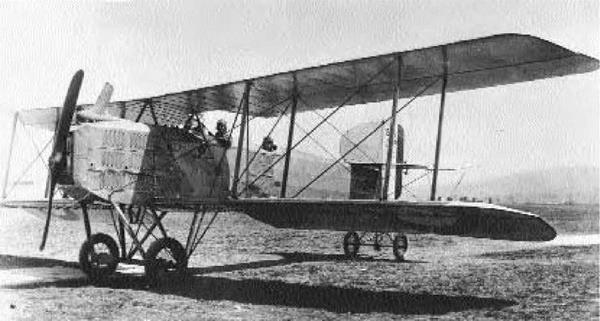
Type: Light Bomber; Reconnaissance
Dimensions: wingspan, 47 feet, 1 inch; length, 29 feet, 1 inch; height, 10 feet, 10 inches
Weights: empty, 2,271 pounds; gross, 3, 450 pounds
Power plant: 1 x 300-horsepower Renault liquid-cooled engine
Performance: maximum speed, 114 miles per hour; ceiling, 19,960 feet; range, 435 miles Armament: 2 x 7.7mm machine guns; up to 661 pounds of bombs Service dates: 1917-1932
|
T |
he rugged Breguet 14 was the best French bomber of World War I, as well as an outstanding aircraft in general. It enjoyed a career of impressive longevity and established many aviation records throughout the postwar period.
In 1916 the talented aviation engineer Louis Breguet undertook designing a new bomber/obser – vation plane for the Aviation Militaire (French air service). He deliberately disregarded specifications for a pusher-type aircraft and developed a conventional-looking machine that was years ahead of contemporaries. The Breguet Model 14 was a large, angular craft with square wings displaying a slightly negative stagger. The fuselage was constructed mostly of the metal duralumin, which contributed greatly to its lightness and strength. Moreover, to improve the aircraft’s agility, ailerons were fitted on both upper and lower wings, along with automatic flaps—one of the earliest applications of this technology. Despite its size, the Breguet 14 was fast and strong, features that prompted the government to commence wholesale production in 1917. Within a
year, Breguet’s magnificent design outfitted no less than 93 French bombardment and reconnaissance squadrons. It also went on to equip two Belgian formations and a number of units attached to the newly arrived American Expeditionary Force. By war’s end, no less than 3,500 had been deployed, dropping 1,900 tons of bombs on German targets.
After the war, the mighty Breguet went on to distinguish itself in a number of nonmilitary applications. It was the first aircraft assigned to fly postal routes between Paris, Brussels, and London, and it registered several record-breaking endurance flights. In January 1919 a Breguet 14 flown by Captain Coli and Lieutenant Roget successfully crossed the Mediterranean twice, covering 1,000 miles without mishap. Throughout the 1920s, it was also widely used to fly the route between Toulouse, France, and Dakar, West Africa. The Breguet 14 underwent no less than 14 revisions and served with the French air force until 1932. It remained in production until 1927, with more than 8,000 being constructed.
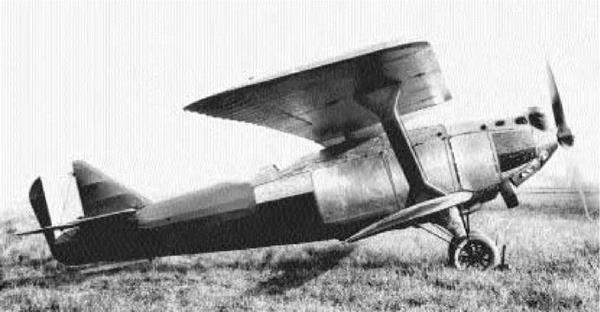
Type: Reconnaissance; Light Bomber
Dimensions: wingspan, 48 feet, 8 inches; length, 31 feet, 2 inches; height, 10 feet, 11 inches
Weights: empty, 2,645 pounds; gross, 4,850 pounds
Power plant: 1 x 450-horsepower Lorraine water-cooled in-line engine
Performance: maximum speed, 137 miles per hour; ceiling, 22,970 feet; range, 497 miles
Armament: 2 x 7.7mm machine guns; up to 1,543 pounds of bombs
Service dates: 1924-1939
|
T |
he Breguet 19 was one of the most successful machines of the interwar period, built in greater numbers than any contemporary. Throughout a lengthy military career it helped establish many world long-distance records.
Immediately after World War I, a design bureau under Louis Vullierme commenced work on a successor to the famous Breguet 14. The prototype was displayed at Paris in 1921 and flew the following year. The new Breguet 19 was a two-seat biplane with a structure built entirely of metal. The wings were unequal in length, with the top exhibiting greater span and twice the chord. Both were fabric – covered and fastened by a single interplane strut canting inward. Unlike its boxy predecessor, the new craft sported a circular cross-section and landed on two streamlined landing gears. It was initially powered by a 450-horsepower Breguet-Bug – gatti engine, and it was fast and maneuverable. Consequently, the French Armee de l’Air acquired more than 1,000 machines, equally divided between bomber and reconnaissance versions. These re
mained in frontline units until 1939, rendering excellent service.
The Breguet 19 was proudly demonstrated in 1923 at the international fighter contest in Spain, where it made a profound impression. Orders from Yugoslavia soon followed, and Spain agreed to manufacture it under license. The 177 CASA-built machines subsequently served both sides during the Spanish Civil War, and many Yugoslavian Breguet 19s fought against German forces in 1940. The secret of the Breguet’s success was its ability to be refitted with successively more powerful engines without extensive modifications. Several of these machines went on to establish impressive long-distance records. In 1927 the craft Nungesser-Coli flew around the world from Paris to Tokyo, covering 35,400 miles in 350 hours. Another famous Breguet 19, the Point d’ Interrogation (Question Mark) also flew nonstop from Paris to Manchuria in 1929, a total distance of 4,912 miles. This same craft also flew nonstop from Paris to New York in 1930 and subsequently toured the United States amidst great fanfare.
|
Dimensions: wingspan, 50 feet, 5 inches; length, 31 feet, 8 inches; height, 10 feet, 5 inches Weights: empty, 6,636 pounds; gross, 10,803 pounds Power plant: 2 x 700-horsepower Gnome-Rhone 14M-6/7 radial engine Performance: maximum speed, 304 miles per hour; ceiling, 27,885 feet; range, 840 miles Armament: 4 x 7.7mm machine guns; 1 x 20mm cannon; 880 pounds of bombs Service dates: 1939-1940
|
T |
he Breguet 691 was among the best French aircraft of World War II. Fast and rugged, it was never available in sufficient numbers to have an impact.
A 1934 French Air Ministry announcement calling for a new three-seat fighter resulted in six contestants. The Breguet firm, however, felt the new specifications were restrictive, so it dropped out to experiment with a heavier, more adaptable design as a company project. The ensuing Model 690 of 1937 proved a radical departure from the company’s angular, ugly biplanes. It was an all-metal, twin-engine, high-wing monoplane with extremely smooth lines. The puglike nose was rather short, not protruding beyond the propeller spinners, and the craft also mounted twin rudders. However, because the Model 690 was not officially sanctioned, it enjoyed little priority on engines and could not be flown until 1938. Flight results were excellent, and it demonstrated better performance than the Potez 63, the aircraft that won the earlier competition. It was also faster than the Morane-Saulnier MS 406, the stan
dard French fighter, and easily kept apace with the new Dewoitine D 520. The usually indifferent French government was impressed, and in 1939 it finally authorized production.
Breguet soon spawned an entire family of related machines. The Breguet 691 was a two-seat ground attack version, of which 78 were constructed. These were followed by the Breguet 693, featuring bigger engines; production totaled 224 planes. The final version was the Breguet 695, again with differing engines, which amounted to 50 units. However, acute part shortages meant that only half of these excellent airplanes were combat-ready when the Germans invaded in May 1940. Breguet 691s engaged in heavy fighting around Belgium and distinguished themselves in low-level attacks on German troops. But because fighter escorts were unavailable, half of these fine machines were lost in combat. After France’s capitulation, many surviving Breguet 691s were impressed into the Italian air service, but those confiscated by Germany had their engines removed and were scrapped.
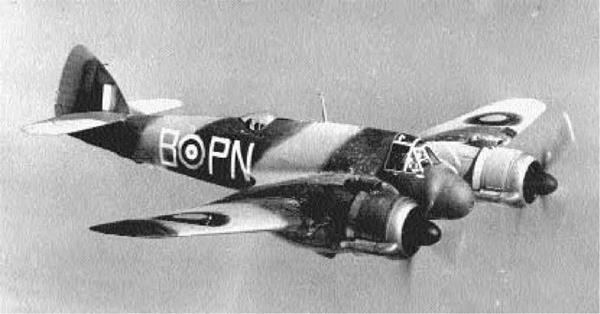
Type: Fighter; Night Fighter; Torpedo-Bomber
Dimensions: wingspan, 57 feet, 10 inches; length, 41 feet, 8 inches; height, 15 feet, 10 inches
Weights: empty, 14,600 pounds; gross, 21,600 pounds
Power plant: 2 x 1,670-horsepower Bristol Hercules XVI radial engines
Performance: maximum speed, 333 miles per hour; ceiling, 26,500 feet; range, 1,480 miles
Armament: 4 x 20mm cannons; 6x.303-inch machine guns; 2,000 pounds of bombs or rockets
Service dates: 1940-1957
|
T |
he mighty Beaufighter was the first dedicated night fighter employed by the Royal Air Force (RAF), and it helped pioneer radar-directed ground – controlled intercepts. It also functioned brilliantly as a torpedo-bomber, sinking scores of Axis vessels.
By 1938 the coming crisis in Europe highlighted Britain’s deficiency in modern long-range fighters. That year Leslie Frise of Bristol commenced a company-funded project to design a large aircraft of unprecedented range and firepower. To save time, he utilized the tail and rear fuselage of the Bristol Beaufort then in production. The prototype Beaufighter first flew in September 1939 as a midwing, all-metal monoplane, with retractable undercarriage and hydraulically operated split flaps. Moreover, it was fitted with no less than four 20mm cannons in the belly and six.303-inch machine guns in the wings. Test flights proved that the Beaufighter was fast and maneuverable for its size, so the RAF decided to employ them as night fighters. Accordingly, they were fitted with the top-secret A/I radar system. These machines debuted in October 1940
and, guided by ground radar to their targets, destroyed many bombers. Losses proved so severe that the Germans were forced to cancel their nighttime blitz of January 1941. Beaufighters also served as long-range fighters in the Mediterranean and Western (Sahara) Desert until replaced by the even more capable de Havilland Mosquito.
Experiments in 1942 demonstrated that the Beaufighter could easily adapt to torpedo warfare. Consequently, RAF Coastal Command created several antiship strike wings of Beaufighters armed with torpedoes as well as rockets. They also carried the ASV Mk VII antishipping radar, housed in a unique thimble-shaped nose. These played havoc with Axis shipping, and one occasion the radar – equipped Beaufighters sank five U-boats in two days. In the Pacific, Japanese soldiers dubbed the big fighter “Whistling Death” on account of its quiet approach. By war’s end, no less than 5,562 Beau- fighters had been produced in England and Australia. The Aussie machines subsequently served as target tows and utility aircraft up through 1957.
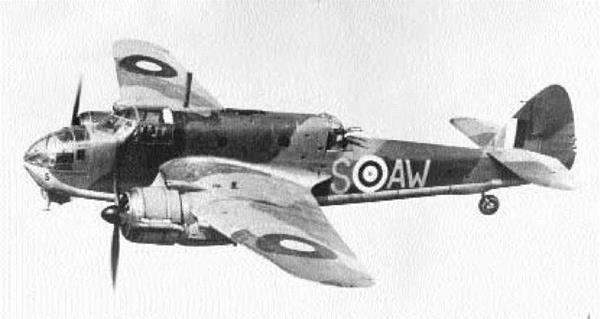
Type: Torpedo-Bomber; Reconnaissance
Dimensions: wingspan, 57 feet, 10 inches; length, 44 feet, 3 inches; height, 14 feet, 3 inches
Weights: empty, 13,100 pounds; gross, 21,228 pounds
Power plant: 2 x 1,130-horsepower Bristol Taurus radial engines
Performance: maximum speed, 265 miles per hour; ceiling, 16,500 feet; range, 1,600 miles Armament: 6 x.303-inch machine guns; 2,000 pounds of bombs or torpedoes Service dates: 1940-1945
|
T |
he Beaufort was the Royal Air Force’s standard torpedo-bomber for most of World War II. It performed excellent service in many theaters and was also mass-produced in Australia.
In 1935 the British Air Ministry issued specifications for new aircraft to replace the aging Vickers Vildebeest as its standard torpedo-bomber. This announcement was later revised to include a similar craft to also serve as a reconnaissance bomber, but both versions were mandated to have crews of four. In 1938 Bristol, then engaged in manufacturing the Blenheim, flew a new prototype that mounted the new Taurus radial engines, prone to overheating. The new Beaufort was essentially an enlarged Blenheim, being an all-metal, midwing monoplane. Unlike its forebear, it had a high cabin roof ending in a semi-enclosed power turret. The bomb bay was also considerably enlarged to accommodate a torpedo. Tests were successful, and Beauforts starting arriving in the fall of 1939, but they were beset by engine problems. Consequently, most aircraft remained grounded until the spring of 1940. It was not
until that April that Beauforts successfully conducted their first mining operations. Soon after they also delivered 2,000-pound bombs for the first time, and gradually they acquired a reputation for reliability and strength. Perhaps their most celebrated action was the futile attempt on April 6, 1941, to prevent the German warships Scharnhorst and Gneisenau from escaping the English Channel, in which many Beauforts were sacrificed. A total of 1,429 were built.
Beauforts subsequently served with distinction throughout the Mediterranean, and squadrons based on Malta were especially effective at harassing Axis shipping. They remained so employed until 1944, when that task was assigned to new Bristol Beau – fighters. In 1939 the Australian government also expressed interest in building the Beaufort under license. They were fitted with more powerful engines and, consequently, a taller tail fin. The 700 Australian – built Beauforts saw extensive service in the Pacific, bombing and torpedoing their way across New Guinea, New Britain, Rabaul, and the East Indies.
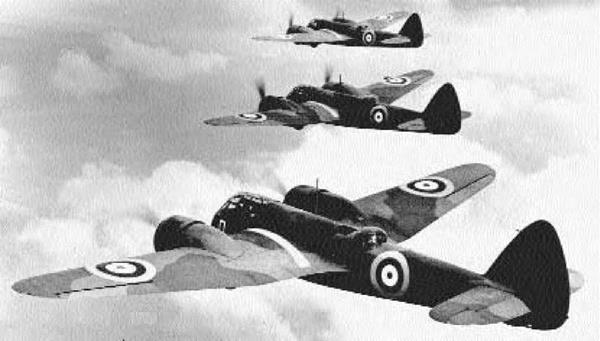
Type: Light Bomber; Night Fighter
Dimensions: wingspan, 56 feet, 4 inches; length, 42 feet, 7 inches; height, 9 feet, 10 inches
Weights: empty, 9,790 pounds; gross, 13,500 pounds
Power plant: 2 x 920-horsepower Bristol Mercury XV radial engines
Performance: maximum speed, 266 miles per hour; ceiling, 22,000 feet; range, 1,460 miles
Armament: 3 x.303-inch machine guns; 1,300 pounds of bombs
Service dates: 1937-1944
|
U |
ltramodern in its day, the Blenheim had grown obsolete by World War II. Despite sometimes heavy losses, it nonetheless saw widespread service with every branch of the Royal Air Force and in every theater.
The Blenheim had its origins in a commercial transport built for newspaper magnate Lord Roth- mere of the London Daily Mail. Entitled Type 142, it was an all-metal, low-wing, snub-nosed monoplane with twin engines and U. S.-built variable-pitch propellers. The new craft caused a sensation by flying 50 miles per hour faster than the newest RAF biplane fighters. Naturally, the Air Ministry was acutely interested in the design, and it issued Specification B.28/35 in order to obtain it. The military version differed specifically in possessing a low wing, a bomb bay, and a power turret. It entered service in 1937 as the Blenheim, at the time the world’s most advanced bombing aircraft. To accommodate additional fuel and range, a long-nosed version was test-flown in 1938.
Technology quickly overtook the Blenheim by the time World War II commenced in 1939, but it constituted the bulk of light bombers within RAF Bomber Command. Various subtypes also served with RAF Fighter Command, Coastal Command, Army Cooperation Command, and Training Command, becoming the only type to do so. On September 3, 1939, Blenheims conducted the first armed reconnaissance over Germany, and the following day they launched the first attack on the German fleet. It was subsequently active in daylight bombing raids but, in view of slow speed and weak armament, sustained heavy losses. The British, however, desperately needed aircraft of any kind, so in 1940 they outfitted Blenheims with top-secret A/I airborne radar, creating the first dedicated night fighter. That August Blenheims achieved the very first nighttime interception of a German bomber. Others served in the Mediterranean, Burma, and Singapore, where they did useful work but suffered heavily. Surviving aircraft were finally transferred to training duties by
1944. Blenheim production ceased at 4,440 machines.
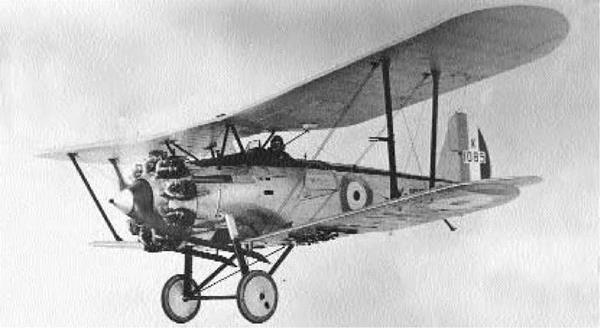
Type: Fighter
Dimensions: wingspan, 33 feet, 10 inches; length, 25 feet, 2 inches; height, 8 feet, 9 inches
Weights: empty, 2,222 pounds; gross, 3,660 pounds
Power plant: 1 x 490-horsepower Bristol Jupiter VIIF radial engine
Performance: maximum speed, 174 miles per hour; ceiling, 29,300 feet; range, 300 miles
Armament: 2 x.303-inch machine guns; 80 pounds of bombs
Service dates: 1929-1937
|
T |
he Bulldog was a mainstay of Royal Air Force fighter strength in the 1930s and represented a shift in Britain’s philosophy toward fighter design. It served with distinction for several years and was also widely exported abroad.
By 1926 the appearance of high-speed bombers such as the Fairey Fox, which could outrun most fighters then in service, induced changes in British fighter philosophy. Thereafter, greater emphasis was placed on speed than maneuverability, although the latter trait still remained significant. The Air Ministry then issued Specification F.9/26, calling for new fighter designs to replace the Gloster Gamecocks and Arm – strong-Whitworth Siskins IIIAs then deployed. Bristol fielded a new craft for the 1927 fighter competition that looked as pugnacious as its name implied: the Bulldog. This was a robust biplane of unequal wingspan whose wings and fuselage frames were constructed of stainless-steel strip for greater strength. Save for metal paneling in the engine area, it was entirely covered by fabric. The single-bay wings had pro
nounced dihedral while the upper one sported a reduced center section to enhance pilot visibility. A variable-incidence tailplane was also fitted so that the craft could be trimmed in flight. The prototype successfully edged out competing designs and won a contract. The first batch, 95 machines, was constructed as Bulldog IIs in 1929 and was greeted with enthusiasm.
A newer version, the Bulldog IIA, evolved by 1930. This differed by the addition of a strengthened structure, higher weight, an improved oil system, and wider undercarriage. A total of 247 were procured, and they represented 70 percent of Britain’s fighter strength over the next few years. In light of its fine performance, the Bulldog was also exported in quantity to Australia, Denmark, Estonia, Sweden, and Finland. Finland kept them in frontline service until 1940, and they fought actively during the Russo-Finnish War. These fine machines, a common sight at the Hendon Displays for many years, were gradually phased out of British service by Gloster Gladiators in 1937.
|
Dimensions: wingspan, 39 feet, 3 inches; length, 25 feet, 10 inches; height, 9 feet, 9 inches Weights: empty, 2,150 pounds; gross, 3,250 pounds
Power plant: 1 x 275-horsepower Rolls-Royce Falcon III liquid-cooled in-line engine Performance: maximum speed, 123 miles per hour; ceiling, 18,000 feet; range, 350 miles Armament: 2 x.303-inch machine guns Service dates: 1917-1932
|
T |
he “Brisfit” was the best general-purpose warplane manufactured during World War I. Its combination of high speed, sound construction, and excellent maneuverability made it a formidable opponent.
By 1916 glaring deficiencies of the BE 2c reconnaissance aircraft necessitated a search for a suitable replacement. Frank Barnwell of Bristol originated such a machine, which first flew in October of that year. Designated the R.2A, it was a conventional, two-bay biplane with some distinguishing features. Foremost among them was a fuselage that sat midway between the two wings, by use of struts, to afford pilots a better forward view. Moreover, it also had a downward sweep toward the tail, which greatly enhanced the gunner’s field of fire. Flight tests were encouraging, so the type entered production as the F.2A.
For such a promising craft, the F.2A had a disastrous combat debut. On April 5, 1917, a flight of six encountered Albatros D IIIs of Manfred von Richthofen’s “Flying Circus,” which promptly shot
down four. Similar losses followed until it was discovered that tactics employed by F.2A crews were faulty, not the aircraft itself. Previously, F.2As were flown as reconnaissance craft, in straight lines and tight defensive formations. This made them easy prey for more agile German fighters. However, as pilots became better acquainted with the big “Bris – fit” they adopted more aggressive tactics. The F.2A, flown offensively, soon emerged as one of the great fighters of the war. By year’s end the improved F 2B was available in numbers and proved an even better dogfighter. For example, on May 7, 1918, two of the newer “Brisfits” were surprised by seven Fokkers yet promptly shot down four. Minutes later they encountered 15 more enemy craft and claimed another four without loss. The F 2B remained in production until 1927, after 5,252 had been constructed. The Royal Air Force employed the big craft in various army cooperation capacities until 1933, and it also saw service in air forces around the world.
|
Dimensions: wingspan, 24 feet, 7 inches; length, 20 feet, 8 inches; height, 8 feet, 6 inches Weights: empty, 760 pounds; gross, 925 pounds Power plant: 1 x 100-horsepower Gnome rotary engine
Performance: maximum speed, 95 miles per hour; ceiling, 14,000; range, 200 miles Armament: none, officially Service dates: 1914-1916
|
V |
ersatile Bristol Scouts were outstanding aircraft for their day but suffered from a lack of armament. They nonetheless saw varied, wide-ranging service, and one was even launched from the back of a seaplane!
In 1913 Frank Barnwell developed a fast single-seat biplane design with a view toward racing it. The prototype, called the Baby, first flew on February 23, 1914, and clocked a respectable 95 miles per hour. The Baby’s fine performance caught the attention of the military, and two additional craft, labeled Scout Bs, were delivered that August. By this time World War I had commenced, and both the Royal Flying Corps and the Royal Naval Air Service began placing orders for the sprightly machine.
The Scout C was the first production model, and it performed reconnaissance service for many months. That role was ironic, for the little Bristol craft was faster and more maneuverable than many German fighters opposing it. Many pilots thus lashed rifles to their Scouts and actively engaged the enemy.
On July 25, 1915, Captain L. G. Hawker won the Victoria Cross when he dispatched three machine gun-armed Albatros scouts with his rifle. That same year an improved version, the Scout D, which featured a more powerful engine and larger tail surfaces, arrived. It too was unarmed, but several squadrons jerry-rigged a wing-mounted Lewis machine gun on the upper wing to fire over the propeller arc. A total of 161 C and 210 D versions were constructed.
The Scouts were basically withdrawn from the Western Front in 1916, but attempts were made to convert it into an anti-Zeppelin device by mounting explosive Ranken darts. In an effort to increase range, two Scouts were nestled aboard the primitive carrier Vindex, and in November 1915 one became the first British aircraft launched from a ship. Experiments were also conducted with the large Porte Baby flying boat, which carried aloft a single Scout C on its wing. This piggyback arrangement proved perfectly functional, and on May 17, 1916, a Scout was successfully launched from an altitude of 1,000 feet.
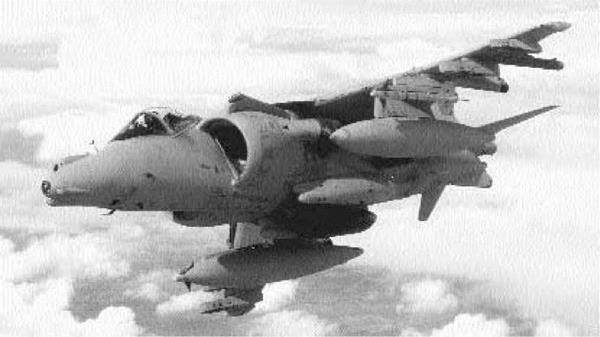
Type: Fighter; Light Bomber
Dimensions: wingspan, 30 feet, 4 inch; length, 37 feet, 1 inch; height, 11 feet, 7 inches
Weights: empty, 15,542 pounds; gross, 31,000 pounds
Power plant: 1 x 21,750-pound thrust Rolls-Royce Pegasus turbofan engine
Performance: maximum speed, 601 miles per hour; ceiling, 51,000 feet; range, 932 miles
Armament: 2 x 30mm cannons; up to 8,000 pounds of bombs or rockets
Service dates: 1968-
|
T |
he Harrier is the first vertical-takeoff fighter in history and among the most maneuverable. It performed sterling service as an interceptor during the 1982 Falkland Islands War and is continually upgraded.
The Harrier concept dates back to 1957 when Sir Sydney Camm of Hawker and Dr. Stanley Hooker of Bristol Siddeley teamed up to design the world’s first vertical takeoff and landing (VTOL) fighter. They employed the new Bristol BS.53 turbofan engine, which directed thrust downward into four vectoring (movable) nozzles. In wartime, such an aircraft could dispense with runways and operate off of any level ground near the front, a tremendous tactical advantage. The prototype P 1127 first flew in October 1960 and was refined through a succession of stronger engines and vectoring configurations. This evolution culminated in 1968, when the first operational Harrier GR 1 appeared. This was a small craft with swept wings of negative dihedral and fuselage centerline landing gear. Four rotatable noz
zles are located on the fuselage to control vertical assent and horizontal flight; two wingtip nozzles provide added stability. As a dogfighter, the Harrier is capable of vectoring in forward flight (vff, or “viff – ing”), literally stopping in midair and causing enemy aircraft to overshoot. Harriers are currently deployed in numbers by the Royal Air Force and U. S. Marine Corps and are operated by the Spanish navy as well.
In 1975 the Royal Navy also acquired its first Sea Harriers. These were initially based closely upon the RAF GR 3 model but were later refitted with a modified canopy and nose section. A total of 57 were purchased; they made aviation history during the 1982 Falkland Islands War with Argentina. Operating as interceptors, they bagged 22 enemy planes without loss, although three were lost to ground fire. These craft have since been superceded by the newer Harrier F/A.2, which utilizes the advanced Blue Vixen radar in a bulbous redesigned nose. India also operates this model in large numbers.











